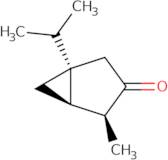Informations sur le produit
- (+)-Isothujone
- (+)-Thujone
- (+)-b-Thujone
- (1S,4S,5R)-1-Isopropyl-4-methylbicyclo[3.1.0]hexan-3-one
- (1S,4S,5R)-4-methyl-1-(1-methylethyl)bicyclo[3.1.0]hexan-3-one
- .beta.-Thujone
- 3-Thujanone, (1S,4S,5R)-(+)-
- 4-Methyl-1-(1-methylethyl)-[1S-(1α,4β,5α)]-bicyclo[3.1.0]hexan-3-one
- 471-15-8
- Bicyclo[3.1.0]hexan-3-one, 4-methyl-1-(1-methylethyl)-, [1S-(1α,4β,5α)]-
- Voir d'autres synonymes
- NSC 67392
- [1S-(1a,4b,5a)]-4-Methyl-1-(1-methylethyl)bicyclo[3.1.0]hexan-3-one
- bicyclo[3.1.0]hexan-3-one, 4-methyl-1-(1-methylethyl)-, (1S,4S,5R)-
- cis-Thujone
- d-Isothujone
- d-β-Thujone
Beta-thujone is a compound that is found in plants such as sage and absinthe. It is a member of the terpene family and has significant cytotoxicity to cells. Beta-thujone binds to the GABA receptor, which is involved in neurotransmission and cell proliferation. The deuterium isotope effect was tested on sodium succinate, which resulted in an increase in beta-thujone's cytotoxicity. Beta-thujone also binds to oxygenated compounds and proteins, both of which are found in human serum and liver tissue. A solid phase microextraction technique was used to extract beta-thujone from human serum samples, while human liver tissue was extracted using a liquid phase microextraction technique.





